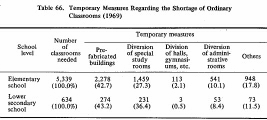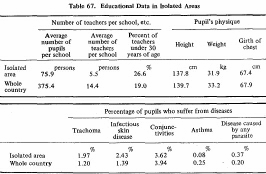| Home > Policy > White Paper, Notice, Announcement > White Paper > EDUCATIONAL STANDARDS IN JAPAN 1971 > CHAPTER |
||
The rapid growth of the society and economy caused by the, Income Doubling Policy and the High Rate of Economic Growth Policy begun around 1960 has induced a wide range of population nobility which has proved itself an important problem at present. Increases or decreases of the general population have created increases or decreases in the number of classes, and consequently in the number of teachers and classrooms. The shortage of classrooms in the public elementary and lower secondary schools in overpopulated areas, into which great numbers have come, is obvious. There was a shortage of 5,974 classrooms in May 1969. Measures were taken to meet this shortage of classrooms, but as a matter of fact about 40%of the rooms constructed for this purpose are prefabricated buildings, in addition to which many rooms for special study are tentatively being used as ordinary classrooms. Various other measures are also taken. For instance a hall or gymnasium is walled into several rooms, the number of pupils in a class is increased, or such irregular systems as the double shift are employed. Cases in which buildings outside the school are rented are also seen. Meanwhile, it is becoming more and more difficult to secure sites for schools, and this is a great problem for the municipalities concerned.
As a result of the shortage of school buildings and grounds, the schools in the affected areas have only small playgrounds, with the result that pupils lack sufficient exercise due to the size of playgrounds. Their durability is below that of pupils in other areas as shown by chinning, arm bending and stretching exercises, strength of back muscles, etc. Furthermore, the number of overweight children has been increasing.
The Ministry of Education has given special attention to the problem of the shortage of school buildings in the overpopulated areas in its Third Five Year Plan for Improving the Facilities of Public Educational Institutions, and it has taken such measures as providing grants for the expense of readjusting land for constructing new school buildings, and considerably raising the ceiling on the sum for the local public debt for the purchase of school sites.

Meanwhile, in sparsely populated areas with large scale population out-migration, there are many problems in securing the services of teachers, transportation to schools, health services and so on. In 1970 the number of public schools in so called "isolated areas" with poor transportation services and cultural defects accounted' for 2l.8% of all elementary schools and l8.9% of all lower secondary schools. The number of pupils in such elementary and lower secondary schools amount to 4.3% at both levels. Generally speaking, most of the schools in isolated areas consist of only one class or a single multi-grade-class. Moreover, pupils are in bad health, and their physique is relatively poor in terms of height, weight and other elements.
In order to improve these conditions, the Ministry of Education is making efforts to raise the educational standards in isolated areas on the basis of the "Law for the Promotion of Education in Isolated Areas". With a view to securing the services of teachers in these areas, steps have been taken such as special allowances for teachers serving in isolated areas, special allowances for teaching multi-grade-classes, special raises in salary with the purpose of promoting personnel exchanges between these areas and other areas, construction of teachers' residences, etc.
As for transportation and health services, the national government has taken such means as supporting the local authorities in the purchase of school buses and boats, bearing transportation fee expenses for pupils who live far from school, bearing expenses for boarding in dormitories, building bathrooms in schools, sending medical doctors and dentists, and increasing the number of nursing teachers for elementary amid lower secondary schools in areas without doctors.
Other measures taken with regard to education in isolated areas include research assignments on education in isolated areas to a certain number of schools, compilation and publication of data on education in isolated areas, and publication of guidance books for teachers relating to instruction in multi-grade classes, and others.
In addition, in April of 1970, The Law Concerning Emergency Steps for Sparsely Populated Areas was enacted. It contains a step which provides that, when small size schools in sparsely populated areas are consolidated, the national treasury's share of the expenses for new construction or enlargement of school buildings or gymnasiums and for construction of teacher's residences shall be raised from a half to two thirds of the total cost.

| Back to Top | MEXT HOME |